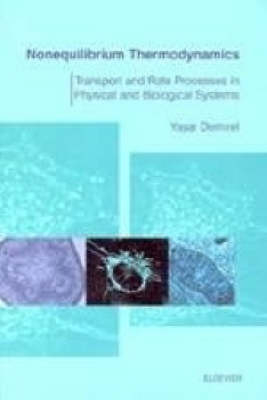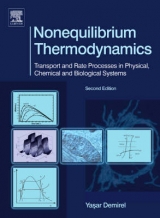
Nonequilibrium Thermodynamics
Elsevier Science Ltd (Verlag)
978-0-444-50886-7 (ISBN)
- Titel erscheint in neuer Auflage
- Artikel merken
The book begins with a brief review of equilibrium systems and transport and rate processes, then covers the following areas: theory of nonequilibrium thermodynamics; dissipation function; entropy and exergy; analysis and case studies on using the second law of thermodynamics; economic impact of the nonequilibrium thermodynamics theory; analysis of transport and rate processes; membrane transport; dissipative structures and biological systems; and other thermodynamic approaches and extended nonequilibrium thermodynamics.
Dr. Yaşar Demirel earned his PhD degree in Chemical Engineering from the University of Birmingham, UK in 1981. He carried out research and scholarly work at the University of Delaware between 1999 and 2001. He worked at Virginia Tech in Blacksburg as a visiting professor between 2002 and 2006. Currently, he is a professor in the Department of Chemical Biomolecular Engineering at the University of Nebraska, Lincoln. He has accumulated broad teaching and research experience over the years in diverse fields of engineering. Dr. Demirel authored and co-authored 11 books, four book chapters, and more than 170 research papers. The fourth edition of Nonequilibrium Thermodynamics was published in 2019. The third edition of the book titled “Energy: Production, Conversion, Storage, Conservation, and Coupling was published in 2021. He co-authored the book “Sustainable Engineering to be published in early 2023 by CRC Press, Taylor & Francis. He has obtained several awards and scholarships and presented invited seminars.
Preface 1. Equilibrium Thermodynamics 1.1. Basic Definitions 1.2. Reversible and Irreversible Processes 1.3. Equilibrium 1.3.1. Fundamental Equations 1.3.2. Thermodynamic Equilibrium 1.4.1. The Zeroth Law of Thermodynamics 1.4.2. The First Law of Thermodynamics 1.4.3. The Second Law of Thermodynamics 1.4. Thermodynamic Laws 1.5. Entropy and Entropy Production 1.6. The Gibbs Equation 1.7. Equations of State 1.8. Thermodynamic Potentials 1.8.1. Cross Relations 1.8.2. Extremum Principles References2. Transport and Rate Processes Introduction 2.1. Nonequilibrium Systems 2.2. Kinetic Approach 2.3. Transport Phenomena 2.3.1. Momentum Transfer 2.3.2. Heat Transfer 2.3.3. Mass Transfer 2.4. The Maxwell-Stefan Equations 2.5. Transport Coefficients 2.6. Electric Charge Flow 2.7. The Relaxation Theory 2.8. Chemical Reactions 2.9. Coupled Processes References3. Linear Nonequilibrium Thermodynamics Introduction 3.1. Local Thermodynamic Equilibrium 3.2. Second Law of Thermodynamics 3.3. Phenomenological Equations 3.3.1. Flows and Forces 3.4. Curie-Prigogine Principle 3.5. Dissipation Function 3.6. Variation of Entropy Production References4. Balance Equations and Entropy Generation 4.1. Introduction 4.2. Entropy Generation Equation 4.1.1. The Mass Balance Equations 4.1.2. The Momentum Balance Equations 4.1.3. The Energy Balance Equations 4.1.4. The Entropy Balance Equations References5. Entropy and Exergy 5.1. Entropy 5.1.1. Entropy Balance 5.2. Exergy 5.2.1. Exergy Balance 5.2.2. Flow Exergy 5.2.3. Exergetic (Second Law) Efficiency 5.2.4. Chemical Exergy 5.2.5. Depletion Number References6. Using The Second Law of Thermodynamics Introduction 6.1. Second Law Analysis 6.1.1. Optimization Problem 6.2. Heat and Fluid Flow 6.2.1. Case Studies 6.3. Heat and Mass Transfer 6.3.1. Case Studies 6.4. Chemical Reactions and Reacting Flows 6.4.1. Case Studies 6.5. Separation 6.5.1. Extraction 6.5.2. Distillation 6.5.3. Case Studies References7. Thermoeconomics Introduction 7.1. Thermodynamic Analysis 7.2. Thermodynamic Optimum 7.2.1. Exergy Analysis 7.2.2. Exhaustion of Renewable Resources 7.2.3. Ecological Cost 7.3. Availability 7.4. Exergy Destruction Number 7.5. Equipartition and Optimization References8. Diffusion Introduction 8.1. Maxwell-Stefan Diffusivity 8.2. Diffusion in Nonelectrolyte Systems 8.3. Diffusion in Electrolyte Systems 8.4. Irreversible Processes in Electrolyte Systems References9. Heat and Mass Transfer Introduction 9.1. Heat and Mass Transfer 9.2. Heat of Transport 9.3. Degree of Coupling 9.4. Coupling in Liquid Mixtures 9.4.1. Coupling in Binary Liquid Mixtures 9.4.2. Coupling in Ternary Liquid Mixtures References10. Chemical Reactions Introduction 10.1. Dissipation For Chemical Reactions 10.1.1. Michaelis-Menten Kinetics 10.2. Coupled Chemical Reactions 10.2.1. Two-Reaction Coupling References11. Membrane Transport Introduction 11.1. Passive Transport 11.1.1. Composite Membranes 11.1.2. Electrokinetic Effect 11.2. Facilitated Transport 11.3. Active Transport References12. Thermodynamics and Biological Systems Introduction 12.1. Mitochondria 12.2. Bioenergetics in Mitochondria 12.3. Oxidative Phosphorylation 12.4. Proper Pathways 12.5. Multiple Inflection Points 12.6. Coupling in Mitochondria 12.6.1. Variation of Coupling 12.7. Thermodynamic Regulation in Bioenergetics 12.7.1. Uncoupling 12.7.2. Slipping 12.7.3. Potassium Channels 12.7.4. Metabolic Control Analysis 12.8. Facilitated Transport 12.8.1. Kinetic Formulation 12.8.2. Nonequilibrium Thermodynamic Approach 12.9. Active Transport 12.10. Molecular Evolution 12.11. Molecular Machines 12.12. Evolutionary Criterium References13. Other Thermodynamic Approaches Introduction 13.1. Network Thermodynamics With Bond Graph 13.1.1. Transport Processes 13.1.2. Chemical Processes 13.2. Mosaic in Nonequilibrium Thermodynamics 13.3. Rational Thermodynamics References14. Extended Nonequilibrium Thermodynamics Introduction 14.1. Stability 14.2. Ordering in Physical Structures 14.2.1. Ordering in Convection 14.2.2. Ordering in Chemical Reactions 14.3 Ordering in Biological Structures 14.3.1. Ordering in Time: Biological Clocks 14.4. Bifurcation 14.5. Extended Nonequilibrium Thermodynamics ReferencesAppendixSymbolsIndex
| Erscheint lt. Verlag | 22.11.2002 |
|---|---|
| Verlagsort | Oxford |
| Sprache | englisch |
| Maße | 165 x 240 mm |
| Gewicht | 930 g |
| Themenwelt | Naturwissenschaften ► Chemie ► Physikalische Chemie |
| ISBN-10 | 0-444-50886-4 / 0444508864 |
| ISBN-13 | 978-0-444-50886-7 / 9780444508867 |
| Zustand | Neuware |
| Informationen gemäß Produktsicherheitsverordnung (GPSR) | |
| Haben Sie eine Frage zum Produkt? |
aus dem Bereich



